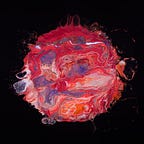In between life’s beginning and end, we discover a myriad succession of emotions, experiences, and encounters. May it be filled with objects, people, discoveries, or an amalgamation of anything possible. Life, in general, is a natural progression to degression — like a bell curve, you could say. Or a mathematical measurement of sorts. In between birth and death, there is only uncertainty. Those points of uncertainty within and beneath the curve are what we all know as life. As we discovered about time, we started measuring that uncertainty, to gain snippets of certainty as a result of our need to feel secure. From days ’til nights, to nights measured months, and from months to years, we conjugate it as our own — age. The phases of life have become a measurable number then, and now in seconds, milliseconds, microseconds, nanoseconds.
Measurement wasn’t always a bad thing, until we quantified the quality of our in-betweens. And not only with time do we do this with, but with every tiny experience, we have associated it with ‘more’ or ‘less.’ More this, less that. Language is a powerful tool. It either makes us or breaks us. And with every relativity and subjectivity of words we say, it creates a rippled impact to our lives and to the world. As once person says ‘more’, another may say ‘less’ or can turn to ‘more.’ More is the trend. More is it. We always want more. Eventually, we believe that life is a natural progression to infinite times. Though not with age do we applied it to, but the false belief of more transcends into wider aspects of our brain, our soul, our body, our entirety. It consumes us, until we no longer can measure our infinite need for more. Instead, we believe our life is now a positive slope in a cartesian plane. More loses valuableness of life. We lose track of what is valuable to us.
Value is a very subjective thing. Yes, they, like age and time, are measured in monikers of numbers — especially with fields relating to mathematics and science. Evolution of man allowed space for research to thrive as we developed using quantity as the best measurement of credibility. But, does value always lie there? Value is equally a quantitative concept. This idea is not a revolutionary discovery but has now been obscured and forgotten with our obsession with more.
That exponential craving to ‘more’ has deprecated what it means to be human — to be present in a human experience. The eventual obsession catalysed our lost sight of creating and finding value in it. Because value does not lie in more, but it does not lie in less either.
Over the course of our species’ existence on Earth, we have redefined and attempted to refine many definitions of what life is like. Now, I neither have a groundbreaking claim to answer where value originates and where should we derive it from, because it is universally abstract and of absolute personal meaning. The idea of less and more is like birth and death. Birth begins with minimal knowledge. Biologically, inside of our mother’s uterus, we have been formed to do basic actions. But with death, ends with a higher degree of experience. And in between, did we gain consciousness.
Yet, consciousness should be coupled with balance. A balance of the bell curve — with discovery and realizations. Yes, there is no accurate formula, nor balance is the perfect way to life. But beneath the curve, we should find points of our lives scattered, mirroring the curve as a symmetry. No more, no less. Until we acknowledge for sure, that even if the most certain points of our lives, birth and death, is in similar notion more and less, does not mean they should be.
